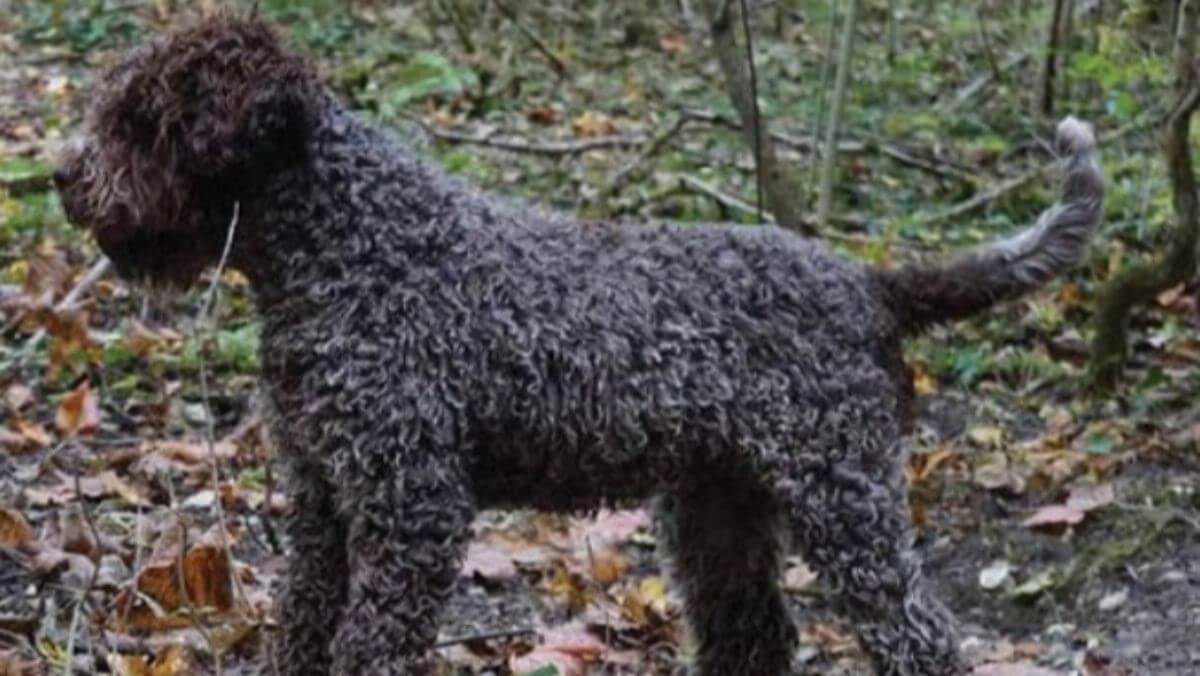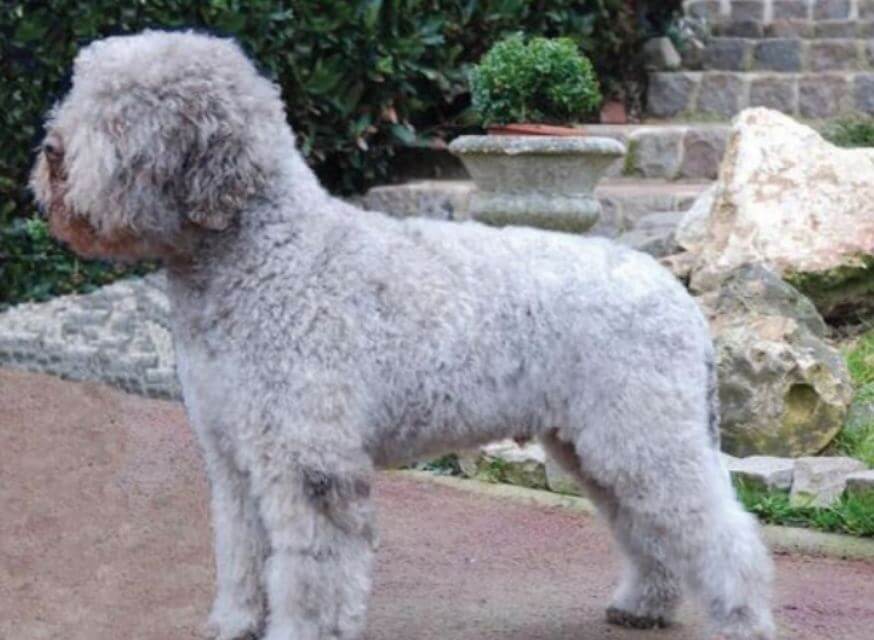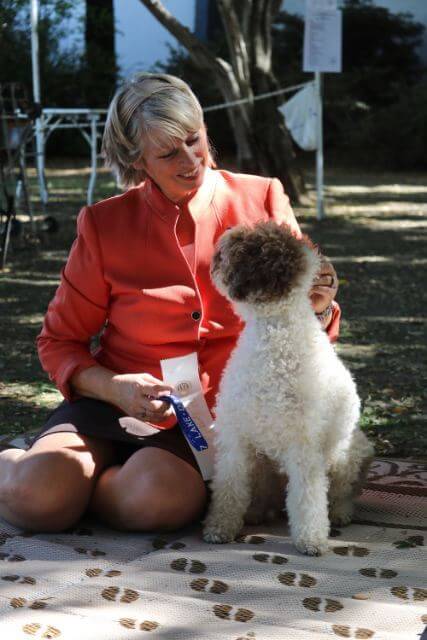
Home » Key Changes to Understanding the Lagotto Romagnolo Standard

This article was originally published in Showsight Magazine, August 2021 issue.
The Lagotto Romagnolo has a new AKC Breed Standard in place as of March 2020. Unfortunately for all, this occurred during quarantine when not a lot of opportunities were available to talk about the changes—and exactly what we were referring to with a variety of word choices and changes in phrases. We want to take a moment to review three areas of the standard that seem to still need clarifying: The addition of the word “Gray”; the Reverse Scissor Bite; and the concept of “Rustic” presentation as it applies to grooming.
So, our standard has been revised… is that cheering we hear? For the last seven years, I have heard from many judges that our Lagotto Romagnolo standard was so complicated that you needed a protractor to understand what was expected to examine our breed. The purpose of the breed revision was not to change what we hope to present to you as judges, but instead, to make it more user-friendly and keep with the intent of the original Italian standard. The changes that were made were in hopes of allowing you, as judges, more time to evaluate the dogs’ conformation without having to spend extra time hunting for dewclaws or taking time to count teeth in your endeavor to check for DQ’s. These changes keep us in line with the Italian/FCI Standard and DQ’s for the Lagotto.
One of the things that may not be as clear with our new change (unless you read through the new color description) is the DQ for Black or… and here may be a confusing part… Gray.

Color: Lagotti can be an off-white solid color, white with brown or orange patches, brown roan, orange roan, brown, orange, or sable (in different shades), with or without white. Some dogs have extremities darker than their body color. Tan markings (in different shades) are allowed. The colors have a tendency to fade, sometimes to such an extent that the brown areas can appear as silvery/gray roan. All the above colors are equally desirable, including the faded or diluted colors. Disqualification: “Black or gray coat or patches; black pigmentation.” So, in one sentence, the Standard says: “The colors have a tendency to fade, sometimes to such an extent that the brown areas can appear as silvery/gray roan. All the above colors are equally desirable, including the faded or diluted colors.” Then we have a DQ for Gray… The issue here is that the faded coat can look silvery gray. These faded coats are not shades of black, which is the intent of the DQ here. Often what is perceived as “Gray” is, in reality, the mixture of a variety of hair types and hair colors. The wiry hair that is present throughout the coat on mature dogs is often white, thus adding a “frosty appearance” to the dog. Careful examination will show that it is, in fact, a mixture of white hairs and brown hairs—NOT individual hair shafts that are gray in color. Included here are examples of dogs that are faded brown, but are not gray.

We are still hearing of judges who are calling a reverse scissor bite an undershot bite. Our Standard clearly states: Disqualification: “…undershot bite… (where the incisors do not touch those of the opposing jaw).” For the Lagotto Romagnolo, a truly undershot (and DQ) bite is where there is space between the upper and lower incisors. The revision to the standard has tightened up our definition of the bite, which used to allow some space and now does not. This bite is just as it sounds; the lower incisors come up over the upper incisors, tightly. This is a perfectly acceptable bite. Specimens with a reverse scissor bite should NEVER be ignored in favor of dogs with minor and major faults. As a reminder: Please note that we are no longer a full mouth exam; front and side checks of the bite will suffice.
One of the things we are always asked about is grooming. What makes a dog “rustic” and another dirty? What makes a dog groomed to perfection and another overdone and sculpted? The Standard says: “Hair should be of wooly texture, semi-rough on the surface. Topcoat should be quite thick, and undercoat visible… A correct coat is never luxurious or shiny.” A correct coat is the product of two things; texture and curl. The undercoat must not be pulled out, it should be visible. Parting the hair lightly should not reveal the skin. From the Standard: “The Correct trim must always be unpretentious, and contribute to the natural, rustic look typical of the breed.” The cut of the dog follows the form of the body. Except for the head, the body should be approximately the same length all over, which is up to 1.5 inches in length. (For many of us, this is approximately the same length as dipping your pinky finger into the coat and having it reach the second knuckle.) This includes the leg furnishings. Leg furnishings that flow or move when the dog moves are TOO LONG. However, it must always be long enough to curl. Different types of curl do affect the grooming. A mature Lagotto coat happens between age two and three. Usually, it appears on the withers and spreads down the back and up the neck, and finally down the legs.
A Lagotto may have large curls (size of a dime) or small ones (pencil eraser), and anything in between. All are correct. Depending on the individual, you may see puppies that don’t appear to have good curl. But, if they have been prepared correctly, i.e., drip-dried, you should be able to dip your fingers down into the coat and feel the hair separating into little groups (like a strand of yarn) where the hair is coming together to make/begin to make curls. The grooming of these dogs should never remind you of a topiary sculpture, perfectly clipped, with curls present only at the tips of the hair. Curls, whatever their size, should be visible and go all the way to the skin itself. The coat must not be blown out—especially the legs! Our standard clearly says that overgroomed or incorrectly groomed dogs are to be penalized: “Corded dogs or excessively groomed dogs (sculpted or blown out) should be so severely penalized as to be eliminated from competition.” Please do not encourage such practices in your judging. Dogs that are presented to you in this manner have deprived you of the chance to evaluate their unique coat. This is a defining feature of the breed, and we must not lose it in a cloud of hair products and procedures.